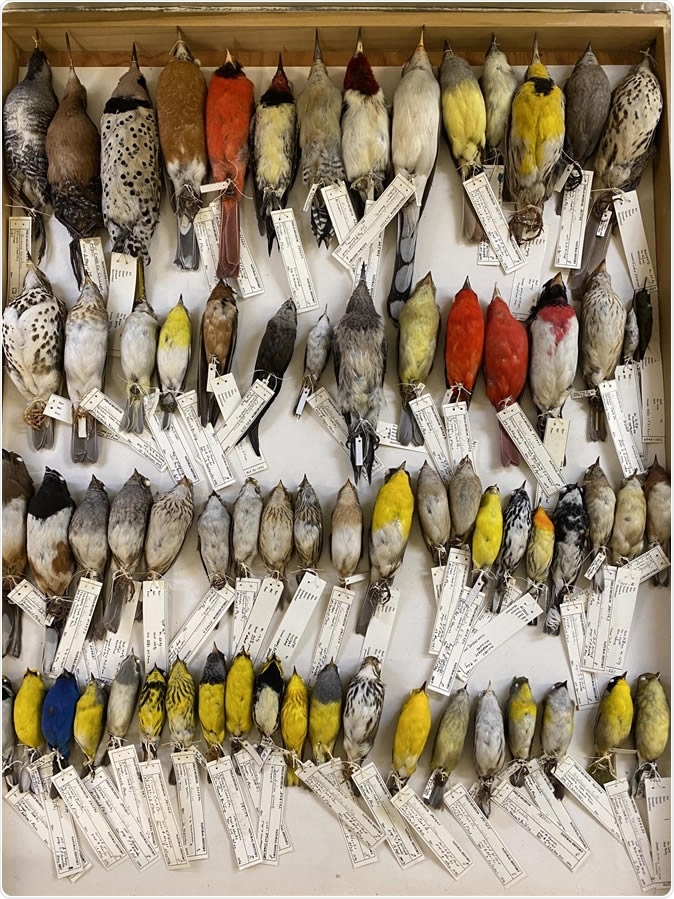A new study published Wednesday in the journal Ecology Letters reports that its look at the physical data of thousands of dead American migratory birds collected off the busy streets of high-rise Chicago shows a surprising fact. Namely, the average size of birds of all sorts has been shrinking over the forty years since the collection began, while their wingspan has increased. The scientists say these changes are adaptations to climate change. Is this a taste of things to come – for humans as well as for birds?

Some of the birds collected at Chicago’s McCormick Place that are in the Field Museum collections. Image credit: Field Museum, Ben Marks.
How it all started
More than 600 million birds – many flying between Canada and Latin America – collide with tall buildings and die. For Dave Willard, who lives in Chicago, collecting these carcases has another aim than merely taking a head count. As he picks up hundreds of dead birds – up to 300 a day at the peak of migratory season – he measures their length and weight and enters these statistics in a book.
At the beginning, the collection was simply so the dead birds wouldn’t go to waste. When Willard, who is collections manager emeritus at the Field Museum of Natural History, heard of these cases, he says he thought, “Why let them go to waste when they could be specimens in a museum?” All they thought about then was finding out how bird morphology varies between different years and seasons, at most. Climate change had not come to the forefront in those days.
Scientific analysis steps in
The data amassed by Willard and his volunteer team since 1978 has been put to good use by environmental scientists at the University of Michigan. Researcher Brian Weeks says, “We had good reason to expect that increasing temperatures would lead to reductions in body size, based on previous studies.” However, he admits his team was shocked by the consistent findings of shrinking body size across all species of birds. In a press statement, he comments: “I was incredibly surprised that all of these species are responding in such similar ways.”
The study was based on almost 71,000 birds from 52 different species, all collected between 1978 and 2016. 49/52 species showed significant shrinkage in body size, and the lower leg bone was reduced in length by almost 2.4%. Wingspan went up by 1.3% on average, and the two parameters were inversely correlated. These three trends are the most obvious findings of the current analysis: reduced leg length, smaller body size, and a larger wingspan.
Bergmann’s rule – and climate change
The temperatures at the breeding grounds where the birds spend the summer, north of Chicago, have gone up by about 1 degree Celsius over the period of collection. Animals that inhabit warmer places are known to be smaller overall, compared to the members of the same species that dwell in colder parts of their habitat range. This is called Bergmann’s rule, and researchers think this underlies the current phenomenon. The biologically plausible explanation is that a larger body size helps to keep the animal warm in a cold place, while this is not necessary in warmer temperatures.
But why the larger wingspan? The scientists speculate that this may be a compensatory mechanism to reduce energy expenditure, since the smaller bodies cannot produce as much energy as before, but the birds still need to travel very long distances on their migratory trips.
The changes in body size and wingspan are so gradual that the eye cannot detect them. However, the measurements cannot lie, and this study, the largest in its category, shows “the most consistent large-scale responses for a diverse group of birds,” according to the researchers.
Biologist Brian Weeks says, “Periods of rapid warming are followed really closely by periods of decline in body size, and vice versa. Being able to show that kind of detail in a morphological study is unique to our study, as far as I know, and it’s entirely due to the quality of the dataset that David Willard generated.”
Implications and future directions
This study provides solid evidence of shrinking body size. Earlier studies in 2014 found a similar trend in alpine goats and salamanders.
Now the scientists want to take the data and analyze it further, to see what causes body size to shrink and what produces the changes in shape. One possibility they are exploring is called developmental plasticity – how an animal changes its developmental pattern with its changing habitat or environmental conditions.
So far, most scientists have thought of climate change as producing responses in terms of a shifting geographical range or altered timing of migration, giving birth, and so on. This study suggests that changes in the morphology of the animal is a third very important factor.
In the words of study author Benjamin Winger, “Warming temperatures seem to be having a pretty consistent and almost universal effect on a large number of different species, regardless of other aspects of their biology.”
If so, perhaps humans should be concerned about their morphology as well – in addition to all the social, economic, health-related and environmental implications of climate change already known to exist.
Source:
Journal reference:
Weeks, B.C., Willard, D.E., Zimova, M., Ellis, A.A., Witynski, M.L., Hennen, M. and Winger, B.M. (2019), Shared morphological consequences of global warming in North American migratory birds. Ecol Lett. doi:10.1111/ele.13434